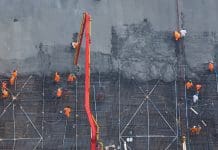Louise Hosking, a chartered health and safety practitioner and director of Hosking Associates, discusses the issues and challenges involved in identifying and monitoring asbestos risk in schools
In my last article (Asbestos risk management: Identification, monitoring and removal), I discussed how a recent Institution of Occupational Safety & Health (IOSH) survey identified that almost one in four construction workers believe they have been exposed to asbestos dust fibres. Almost a third (32%) of respondents said they do not check asbestos registers, putting not only themselves at risk but also others.
From the 1950s through to the 1980s, asbestos was used extensively in the construction of school premises. Asbestos containing materials (ACMs) were used in fireproofing around structural columns and in fire breaks.
ACMs were used extensively by the Consortium of Local Authorities Special Programme (CLASP), which formed in England in 1957 with the purpose of developing prefabricated school and public buildings. The system used light gauge steel frames, which enabled quick and economical construction. Frames were finished in a variety of cladding, many of which had an ACM content.
The Control of Asbestos Regulations 2012 (CAR) is clear about how asbestos must be managed. CAR Regulation 4 is the duty to manage and states:
- Steps must be taken to identify ACMs in non-domestic premises to quantify the amount, detail where it is and what condition it is in (create an asbestos register – this must be kept up to date).
- Presume materials contain ACMs unless you have strong evidence otherwise (eg via sampling or building history).
- Assess the risk of potential exposure, eg it is more likely in a well-used corridor than in a locked space.
- Create a management plan that sets out the arrangements for managing ACMs safely and implement it.
- Periodically review the plan and check it remains relevant.
- Ensure clear information is provided to everyone who might disturb or come into contact with ACMs.
The responsibility for managing ACMs will be with whoever is responsible for maintenance and repair. For schools that are academies, free schools, voluntary-aided and foundation schools, the duty holder will be the trust.
Similarly, for independent schools, this will be the proprietor, governors or trustees. The local authority is responsible for community schools and voluntary-controlled schools where the premises and function have remained under local authority control.
Here lies the problem. When schools moved out of local authority control, they became responsible for budgets in respect of maintenance and repair. The older the school, the higher the cost of managing the buildings.
In 2010, then-education secretary Michael Gove cancelled Labour’s school building programme, suspending 715 new schools as part of a sweeping range of government cuts. Many of the schools in this programme included CLASP buildings. At the time, some schools were undertaking temporary control measures, thinking buildings would be replaced.
At the end of September 2018, head teachers marched on Downing Street demanding an end to seven years of cuts, saying further savings cannot be made. Managing a school with extensive areas of asbestos is a management challenge and an expensive business. Schools are being faced with difficult financial choices.
I’ve worked with schools who’ve had some support from the local authority, or who have commissioned asbestos surveys based on cheapest quotes, which clearly do not cover all school buildings & spaces.
Even where good surveys are undertaken, they might not be up to date and re-inspections of the material not always undertaken – this can be due to lack of understanding as well as lack of funds.

Subsequently, poor condition ACMs may exist in spaces which someone eventually might enter, need to work within or undertake maintenance.
Where schools do have information, it is important the right people know where it is, and the precautions to take in order to protect themselves and others. For schools organising maintenance and repair, this is all about having good contractor management arrangements in place – this means choosing contractors with the right capability for the work and exchanging clear safety information.
The school will provide contractors with details of known site hazards, including asbestos, and the contractors will provide information on how work will be conducted safely. All contractors working in schools should have received asbestos awareness training and sign to say they have seen the register on site. Managing contractors takes time and expertise which our already stretched schools can find challenging.
Schools can get access to grants and central funding for essential works, but it involves a lengthy application process for work that might need to be undertaken right away.
Most schools will have their own caretakers or facilities staff who undertake odd jobs – it is essential they fully understand the processes in place if their school contains asbestos.
In 2013 Marion Potts, a teacher, died from cancer associated with inhaling asbestos dust that was thought to be from placing pins into walls containing ACMs. For this reason, everyone working within schools and for schools should be made aware of precautions in place to protect themselves and others.
Louise Hosking CMIOSH CEnvH MCIEH CMaPS
PIEMA SIIRSM
Director
Hosking Associates
Tel: +44 (0)203 603 6466
https://twitter.com/hoskingassociat
https://www.linkedin.com/company/hosking-associates-ltd














